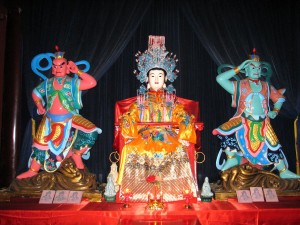In 960 C.E., a girl named Lin Moniang was born on Meizhou Island in China. She was the seventh daughter of a fisherman, said by locals to have extraordinary capabilities. As the years went on, it became clear that Moniang could predict disasters and events with remarkable accuracy–especially when it came to the sea. As a young woman, Moniang became an excellent swimmer and was known for standing on the island’s shore, dressed in red, as she waited for her father and brothers to return from fishing.
One day, a typhoon arose while she awaited their return. In the midst of the storm, she fell into a trance while praying for their safe return. In her dreams, she tried to save her father and brothers from the storm–but her mother was trying to wake her, causing her to lose one of her brothers to the sea. When her father returned, he told the villagers of the miraculous rescue and the loss of one of his sons.
Moniang died in 987. She is thought to have drowned after diving into the sea, attempting to swim to her father and brothers during another typhoon, and then to have ascended to become a goddess.
Today, Moniang is known as the Chinese goddess Mazu, protector of seafarers. Her worship became popular along coastal areas during the Ming dynasty. Cheng Ho, a eunuch appointed by Ming emperors to lead seven overseas adventures, worshipped her on his ship and introduced her to every port he visited after claiming that Mazu had rescued his ship from certain doom.
Mazu is now worshipped in over 1,500 temples in 26 countries–often brought to new shores by the seafarers and immigrants who prayed to her for protection during their voyages. She is often depicted as above, accompanied by two guardian generals/demons, “Thousand Miles Eye” and “With-the-Wind Ear,” whom she is said to have conquered through her martial arts skills.
-Tiffany Rhoades
Program Developer
Girl Museum Inc.

